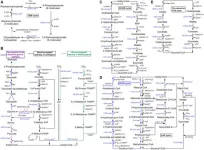(Press-News.org) A clinical trial reported in 2021 and conducted by a team of researchers from Washington University School of Medicine in St. Louis and the International Centre for Diarrhoeal Disease Research in Dhaka, Bangladesh, showed that a newly designed therapeutic food aimed at repairing malnourished children’s underdeveloped gut microbiomes was superior to a widely used standard therapeutic food.
Now, another study from the same research team at Washington University School of Medicine has identified key, naturally occurring biochemical components of this new therapeutic food and the important bacterial strains that process these components. The study suggests that identifying these components and the key growth-promoting gut bacterial strains that function as their therapeutic targets can help guide treatment with the current food formulation and could enable creation of new, more effective formulations in the future.
The study, led by Jeffrey I. Gordon, MD, the Dr. Robert J. Glaser Distinguished University Professor at Washington University, is published Dec. 13 in Nature.
“We have identified bioactive elements of a microbiome-directed food,” said Gordon, who is also director of the Edison Family Center for Genome Sciences & Systems Biology at the School of Medicine. “These are naturally occurring carbohydrate structures that could, in theory, be recovered in large quantities from the byproduct streams of food manufacturing and be used to produce prebiotics. We also have identified the microbes that process these food components, and in theory, there is potential for the organisms themselves to be part of a therapeutic intervention in children completely lacking these beneficial gut microbes.”
Building on this work, the World Health Organization together with the Bill & Melinda Gates Foundation is supporting a large, multisite clinical trial investigating this new therapeutic food — called MDCF-2, or microbiome-directed complementary food. The trial, which is in its early stages, aims to enroll about 6,500 malnourished children, ages 6 months to 2 years, living in Africa and Southeast Asia.
Malnutrition is a leading cause of death in children under age 5, and nearly 150 million children under this age suffer from stunted growth, according to the World Health Organization and the United Nations Children’s Fund. Treatment with traditional therapeutic foods reduces deaths, but it does not substantially improve other long-term effects of malnutrition, including problems with metabolism, bone growth, immune function and brain development.
“Our work has demonstrated that a healthy microbial community in the gut is necessary for healthy growth,” Gordon said. “Development of the gut microbial community in the first two years of life needs to be in sync with the development of the rest of the body, the other organ systems. When this microbial community is incompletely formed, simply giving more calories won’t repair it. We are seeking specific food components that nurture healthy gut microbial communities in hopes of repairing the gut microbial community that has become dysfunctional in children with malnutrition.”
The researchers, including co-first authors Matthew C. Hibberd, PhD, an assistant professor of pathology & immunology, and Daniel M. Webber, MD, PhD, an instructor in pathology & immunology, found that strains of the bacteria Prevotella copri were positively associated with increased growth in the children. These organisms showed increases in the activities of metabolic pathways that use beneficial bioactive carbohydrate structures present in the MDCF-2 therapeutic food. Compared with children receiving the traditional therapeutic food, those receiving MDCF-2 showed higher blood levels of certain proteins that support musculoskeletal growth and neurodevelopment as well as lower levels of proteins involved with inflammation — indicating that the effects of microbiome repair extend well beyond the walls of the gut.
“We performed extensive genomic analyses of fecal samples from these children,” Hibberd said. “We know the identities of the bacteria that are responding to these food components, and the metabolic capabilities these bacteria have and express in response to treatment. It turns out that many of the bacteria strongly associated with growth in the children are enriched in pathways for carbohydrate metabolism.”
In the 2021 clinical trial, the MDCF-2 therapeutic food was given as a dietary supplement to provide about 20% of the children’s daily energy requirements. Ingredients of MDCF-2 include chickpea flour, soybean flour, peanut paste and mashed green banana pulp; the traditional, higher calorie, ready-to-use supplementary food includes rice, lentils and milk powder. Detailed analysis of the carbohydrates in these foods revealed that MDCF-2 contains more polysaccharides known as galactans and mannans, while the traditional therapeutic food contains more starch and cellulose. The children receiving MDCF-2 showed increased growth compared with those receiving the traditional supplementary food, even though the caloric density of MDCF-2 was 15% lower than in the higher calorie food. The increased growth associated with MDCF-2 treatment was correlated with increased expression of metabolic pathways present in certain strains of Prevotella copri in children’s microbiomes — pathways that are involved in the organism’s utilization of polysaccharides present in MDCF-2.
“Information from food frequency questionnaires suggests that the children who had the greatest response to MDCF-2 were also consuming more nuts and legumes as part of their regular diets,” Webber said. “These nuts and legumes possess some of the same polysaccharides as MDCF-2. This suggests that there may be opportunities to adjust the composition and dose of MDCF-2 to further enhance its therapeutic effect.”
Gordon added: “The upcoming clinical trials of MDCF-2 in East and West Africa and in South Asia will test the generalizability of its effectiveness in malnourished children from 6 months to 24 months of age with varying degrees of severity of malnutrition. The results from these and other studies should help advance our understanding of how our microbes collaborate with our human cells and organs to influence developmental biology, refine our approaches for the development of microbiome-directed therapeutics, and help us develop new approaches for feeding our children in order to ensure formation of healthy microbiomes during the first several years of postnatal life.”
END
Gut bacteria of malnourished children benefit from key elements in therapeutic food
Findings could guide recommendations for treating, preventing childhood malnutrition
2023-12-14
ELSE PRESS RELEASES FROM THIS DATE:
Gayle Benson makes historic donation for new home for Ochsner Children’s Hospital
2023-12-14
NEW ORLEANS, La. – Ochsner Health announces plans for The Gayle and Tom Benson Ochsner Children’s Hospital, made possible through a transformational gift from Mrs. Gayle Benson.
“We are proud to unveil much-anticipated plans for a new home for Louisiana’s No. 1 ranked children’s hospital,” said Pete November, CEO, Ochsner Health. “Ochsner is deeply grateful for Mrs. Benson and her unparalleled act of generosity, which will significantly impact the lives of countless families throughout Louisiana and the Gulf South. This facility will enable us to care for more children, retain and attract top pediatric physicians ...
Enzymes can’t tell artificial DNA from the real thing
2023-12-14
The genetic alphabet contains just four letters, referring to the four nucleotides, the biochemical building blocks that comprise all DNA. Scientists have long wondered whether it’s possible to add more letters to this alphabet by creating brand-new nucleotides in the lab, but the utility of this innovation depends on whether or not cells can actually recognize and use artificial nucleotides to make proteins.
Now, researchers at Skaggs School of Pharmacy and Pharmaceutical Sciences at the University of California San Diego have ...
Decline in smoking in England has stalled since pandemic
2023-12-14
A decades-long decline in smoking prevalence in England has nearly ground to a halt since the start of the pandemic, according to a new study led by UCL researchers.
The study, funded by Cancer Research UK and published in the journal BMC Medicine, looked at survey responses from 101,960 adults between June 2017 and August 2022.
Before the Covid-19 pandemic, from June 2017 to February 2020, smoking prevalence fell by 5.2% a year, but this rate of decline slowed to 0.3% during the pandemic (from April 2020 to August 2022), the study ...
3G microbial cell factories: achieving sustainable goals with engineered microorganisms
2023-12-14
Fossil fuels are at the heart of most human activities, contributing to the increase in greenhouse gas emissions and the ever-rising atmospheric carbon dioxide (CO2) levels. CO2 levels are projected to increase exponentially in future, resulting in severe environmental and ecological impacts. A beacon of hope amidst this chaos are eco-friendly alternatives to fossil fuels.
Green energy sources can be developed using advanced biotechnological techniques. One such intervention is the use of biorefineries or microbial cell factories, that convert biomass (organic matter like plants and solid waste) into energy and valuable by-products. The first (1G) ...
Using deep learning to identify teens most in need of mental health support
2023-12-14
The personal yet global struggle with mental health may be more visible now than ever before. Yet many people still find it difficult to access the support they need. In Japan, suicide is sadly the leading cause of death for young people. Researchers, including from the University of Tokyo, have carried out a six-year study to better understand the myriad of factors which can impact adolescent mental health. After surveying 2,344 adolescents and their caregivers, and using computer-based deep learning to process the results, they were able to identify five categories which the young people could be grouped into. Nearly 40% of those involved were ...
The Lancet Psychiatry: Mental health care and research must directly confront systemic racism to improve the health and lives of Black Americans
2023-12-14
Improving the mental health and wellness of Black Americans requires acknowledging and confronting systemic racism underlying the US political, social, and healthcare systems that create and maintain racial inequality in every aspect of life for Black people in the USA.
The new Series of three papers on Black mental health in the USA, plus an essay from Black Americans with lived experience, published inThe Lancet Psychiatry journal, outlines the overwhelming evidence for the role racism plays in producing, maintaining, and amplifying mental health disparities for Black Americans. Against this background, the authors call for a comprehensive analysis of the conditions and systems in ...
Alarm over lax oversight of weight loss drug ads that could harm patients
2023-12-14
UK organisations responsible for protecting the public from prescription-only drug adverts are putting patients at risk from the harms of weight loss drugs by not enforcing the law, reveals an investigation published by The BMJ today.
Legal responsibility for regulating adverts for medicines in the UK rests with the Medicines and Healthcare products Regulatory Agency (MHRA) on behalf of health ministers. But there is also a system of self-regulation with a number of bodies operating their own codes of practice, including the Advertising Standards Authority (ASA).
But The BMJ has found that the MHRA has not issued a single sanction for prescription drugs in the last ...
Post-meal insulin surge not a villain, says new research
2023-12-14
Researchers at Sinai Health have unearthed vital information about the relationship between insulin levels after eating and long-term heart and metabolic health. The research upends the notion that insulin surge following food intake is a bad thing.
On the contrary – it could be an indicator of good health to come.
Led by Dr. Ravi Retnakaran, Clinician-Scientist at the Lunenfeld-Tanenbaum Research Institute, part of Sinai Health, the study set out to explore how insulin levels after meals impact cardiometabolic health. While past ...
Body dissatisfaction linked with depression risk in children
2023-12-14
Body dissatisfaction at age 11 is linked to increased risk of depression by age 14, finds a new longitudinal study led by UCL researchers.
The findings, published in The Lancet Psychiatry, show that body image concerns explain a large proportion of an association between body mass index (BMI) and depression in children, particularly in girls.
The study, supported by Wellcome, involved 13,135 participants of the Millennium Cohort Study, a UCL-led nationally representative birth cohort study of people born between 2000 and 2002.
The researchers found that high BMI at age seven was linked with increased depressive symptoms (which can include low mood, loss of pleasure ...
Study explores accuracy of computerized ADHD test
2023-12-14
A new study cautions against using the QbTest as a standalone diagnostic or screening tool for ADHD.
Rather, the study authors highlight the intended use of the QbTest as a component of a full clinical assessment, since it could help clinicians reach faster diagnostic decisions and reduce waiting lists.
Researchers from the Universities of Southampton, Nottingham, Cardiff, and King’s College London explored the accuracy and clinical utility of a widely used computerised test for Attention-deficit/hyperactivity disorder (ADHD), called the QbTest. They found that, when used on its own, QbTest is not good enough ...
LAST 30 PRESS RELEASES:
Statins significantly reduce mortality risk for adults with diabetes, regardless of cardiovascular risk
Brain immune cells may drive more damage in females than males with Alzheimer’s
Evidence-based recommendations empower clinicians to manage epilepsy in pregnancy
Fungus turns bark beetles’ defenses against them
There are new antivirals being tested for herpesviruses. Scientists now know how they work
CDI scientist, colleagues author review of global burden of fungus Candida auris
How does stroke influence speech comprehension?
B cells transiently unlock their plasticity, risking lymphoma development
Advanced AI dodel predicts spoken language outcomes in deaf children after cochlear implants
Multimodal imaging-based cerebral blood flow prediction model development in simulated microgravity
Accelerated streaming subgraph matching framework is faster, more robust, and scalable
Gestational diabetes rose every year in the US since 2016
OHSU researchers find breast cancer drug boosts leukemia treatment
Fear and medical misinformation regarding risk of progression or recurrence among patients with breast cancer
Glucagonlike peptide-1 receptor agonists and asthma risk in adolescents with obesity
Reviving dormant immunity: Millimeter waves reprogram the immunosuppressive microenvironment to potentiate immunotherapy without obvious side effects
Safety decision-making for autonomous vehicles integrating passenger physiological states by fNIRS
Fires could emit more air pollution than previously estimated
A new way to map how cells choose their fate
Numbers in our sights affect how we perceive space
SIMJ announces global collaborative book project in commemoration of its 75th anniversary
Air pollution exposure and birth weight
Obstructive sleep apnea risk and mental health conditions among older adults
How talking slows eye movements behind the wheel
The Ceramic Society of Japan’s Oxoate Ceramics Research Association launches new international book project
Heart-brain connection: international study reveals the role of the vagus nerve in keeping the heart young
Researchers identify Rb1 as a predictive biomarker for a new therapeutic strategy in some breast cancers
Survey reveals ethical gaps slowing AI adoption in pediatric surgery
Stimulant ADHD medications work differently than thought
AI overestimates how smart people are, according to HSE economists
[Press-News.org] Gut bacteria of malnourished children benefit from key elements in therapeutic foodFindings could guide recommendations for treating, preventing childhood malnutrition



